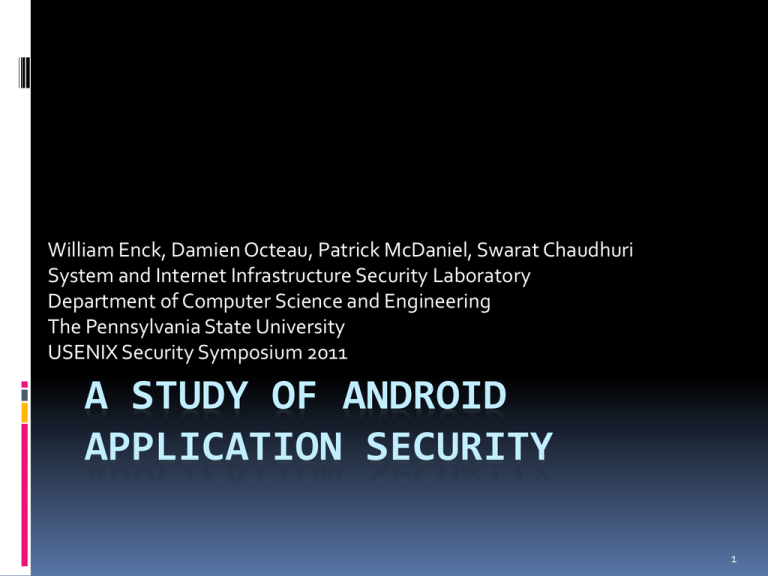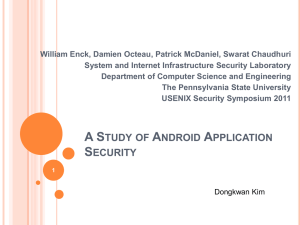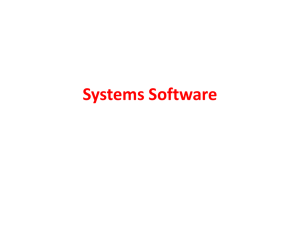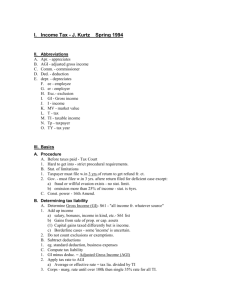A Study of Android Application Security
advertisement

William Enck, Damien Octeau, Patrick McDaniel, Swarat Chaudhuri System and Internet Infrastructure Security Laboratory Department of Computer Science and Engineering The Pennsylvania State University USENIX Security Symposium 2011 A STUDY OF ANDROID APPLICATION SECURITY 1 Outlines Introduction Background The ded decompiler Evaluating Android Security Application Analysis Results Study Limitations What This All Means Conclusions 2 Introduction Markets are not in a position to provide security in more than a superficial way To broadly characterize the security of applications in the Android Market Contributions ded: A Dalvik decompiler. DVM-to-JVM bytecode retargeting. Analyze 21 million LOC from the top 1100 free applicatons 3 Introduction Wide misuse of privacy sensitive information “Cookie-esque” tracking Found no evidence of telephony misuse Ad and analytic network libraries => 51% applications AdMob => 29.09% Google Ads => 18.72% Many applications include more than one ad library Failed to securely use Android APIs 4 Background Android 5 Background Dalvik Virtual Machine JVM => .class DVM => .dex Dalvik dx compiler Constant Pool: -References to other classes -Method names Class Definition: -Numerical constants -Access flags -Class names Data: -Method code -Info related to methods -Variables 6 Background Register architecture DVM: register-based 2^16 available registers JVM: stack-based 200 opcodes 7 Background Instruction set DVM 218 opcodes Longer instructions Fewer instructions 30% fewer instructions, but 35% larger code size (bytes) JVM 200 opcodes 8 Background 9 Background Constant pool structure DVM Single pool dx eliminates some constants by inlining their values directly into the bytecode JVM Multiple 10 Background Ambiguous primitive types DVM int/float, long/double use the same opcodes JVM Different Null references DVM Not specify a null type Use zero value 11 Background Comparison of object references DVM Comparison between two integers Comparison of integer and zero JVM if_acmpeq / if_acmpne ifnull / ifnonnull 12 Background Storage of primitive types in arrays DVM Ambiguous opcodes aget for int/float, aget-wide for long/double 13 The ded decompiler To decompile the Java source rather than to operate on the DEX opcodes Leverage existing tools for code analysis Require access to source code to identify false- positives resulting from automated code analysis 14 The ded decompiler 15 The ded decompiler Application Retargeting Type Inference Constant and variable declaration only specifies 32 or 64 bits Comparison operators do not distinguish between integer and object reference comparison Inference must be path-sensitive 16 The ded decompiler Application Retargeting (cont.) To infer a register’s type Compare with a known type add-int like instruction only operate on specific types Use as return value or parameters of methods (via method signature) Branch Push onto an inference stack DFS 17 The ded decompiler Constant Pool Conversion .dex file vs. .class file Single constant pool vs. multiple constant pool Dalvik bytecode places primitive type constant directly in bytecode 18 The ded decompiler Method Code Retargeting Address multidimensional arrays Bytecode translation ded maps each referenced register to a Java local variable table index Instruction traslation One Dalvik instruction -> multiple Java instructions ded defines exception tables that describe try/catch/finally blocks 19 The ded decompiler Example: 20 The ded decompiler Optimization and Decompilation Soot While the Java bytecode generated by ded is legal, the source code failure rate is almost entirely due to Soot’s inability 21 The ded decompiler Source Code Recovery Validation decompilation time: 497.7 hours 99.97% of total time -> Soot 22 The ded decompiler Retargeting Failures Decompilation Failures 0.59% of classes 5% of classes Unresolved reference Soot Type violations by Decompile traditonal Android dex compiler ded produces illegal bytecode (rare) Java program 94.59% 23 The ded decompiler Future work Fernflower 98.04% recovery rate 24 Evaluating Android Security Analysis Specification Use Fortify SCA static analysis suite Control flow analysis A control flow rule is an automaton 25 Evaluating Android Security Analysis Specification (cont.) Data flow analysis IMEI, IMSI, ICC-ID Data flows between the sources and sinks are violations Structural analysis Semantic analysis Ex: app does not send SMS to hard-coded targets 26 Evaluating Android Security Overview Misuse of Phone Identifiers Exposure of Physical Location Abuse of Telephony Services Eavesdropping on Audio/Video Botnet Characteristics (Sockets) Harvesting Installed Applications Use of Advertisement Libraries Dangerous Developer Libraries Android-specific Vulnerabilities General Java Application Vulnerabilities 27 Application Analysis Results Information Misuse 22.4% Phone Identifiers 19.6% 28 Application Analysis Results Finding 1 - Phone identifiers are frequently leaked through plaintext requests Finding 2 - Phone identifiers are used as device fingerprints Finding 3 - Phone identifiers, specifically the IMEI, are used to track individual users Finding 4 - The IMEI is tied to personally identifiable information (PII) Finding 5 - Not all phone identifier use leads to exfiltration Finding 6 - Phone identifiers are sent to advertisement and analytics servers 29 Application Analysis Results Information Misuse (cont.) Location Information getLastKnownLocation() LocationListener => requestLocationUpdates() 27.6% 45.9% 30 Application Analysis Results Finding 7 - The granularity of location reporting may not always be obvious to the user Finding 8 - Location information is sent to advertisement servers 31 Application Analysis Results Phone Misuse Telephony Services A constant used for SMS destination number Creation of URI objects with “tel:” prefix and the string “900” URI objects with “tel:” prefix Finding 9 - Applications do not appear to be using fixed phone number services Finding 10 - Applications do not appear to be misusing voice services 32 Application Analysis Results Phone Misuse (cont.) Background Audio/Video Recording video without calling setPreviewDisplay() AudioRecord.read() is not reachable from an Android activity component MediaRecorder.start() is not reachable from an activity component 33 Application Analysis Results Finding 11 - Applications do not appear to be misusing video recording Finding 12 - Applications do not appear to be misusing audio recording 34 Application Analysis Results Phone Misuse (cont.) Socket API Use Finding 13 - A small number of applications include code that uses the Socket class directly Finding 14 - We found no evidence of malicious behavior by applications using Socket directly 35 Application Analysis Results Phone Misuse (cont.) Installed Applications A set of get APIs returning the list of installed app A set of query APIs that mirrors Android’s runtime intent resolution Finding 15 - Applications do not appear to be harvesting information about which applications are installed on the phone 36 Application Analysis Results Included Libraries Advertisement and Analytics Libraries 29% 18.7% 51% 37 Application Analysis Results Finding 16 - Ad and analytics library use of phone identifiers and location is sometimes configurable Finding 17 - Analytics library reporting frequency is often configurable Finding 18 - Ad and analytics libraries probe for permissions 38 Application Analysis Results Included Libraries (cont.) Developer Tookits Finding 19 - Some developer toolkits replicate dangerous functionality jackeey.wallapaper sends identifiers to imnet.us Finding 20 - Some developer toolkits probe for permissions checkPermission() Finding 21 - Well-known brands sometimes commission developers that include dangerous functionality 39 Application Analysis Results Android-specific Vulnerabilities Leaking Information to Logs READ_LOGS Finding 22 - Private information is written to Android’s general logging interface 40 Application Analysis Results Android-specific Vulnerabilities (cont.) Leaking Information via IPC Finding 23 - Applications broadcast private information in IPC accessible to all applications 41 Application Analysis Results Android-specific Vulnerabilities (cont.) Unprotected Broadcast Receivers Finding 24 - Few applications are vulnerable to forging attacks to dynamic broadcast receivers Intent Injection Attacks Finding 25 - Some applications define intent addresses based on IPC input 42 Application Analysis Results Android-specific Vulnerabilities (cont.) Delegating Control Pending intent Cannot change values But can fill in missing fields Finding 26 - Few applications unsafely delegate actions UI notification service Alarm service UI widget main application 43 Application Analysis Results Android-specific Vulnerabilities (cont.) Null Checks on IPC Input Finding 27 - Applications frequently do not perform null checks on IPC input 53.7% (591 applications) 44 Application Analysis Results Android-specific Vulnerabilities (cont.) Sdcard Use 22.8% (251 applications) JNI Use 6.3% (69 applications) 45 Study Limitations Application popularity Data and control flows for IPC between components Source code recovery failures ProGuard Obfuscate Protect against readability 46 What This All Means Application certification Misuse of privacy sensitive information Cookie-esque tracking Ad and analytic libraries Free applications! LOG / unprotected IPC 47 Conclusion ded decompiler Dangerous functionality Future work Application installation Malicious JNI phishing 48









